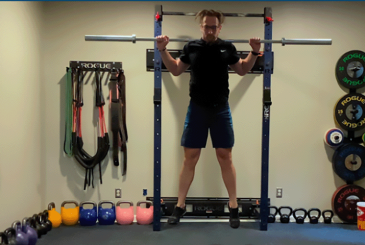In his second article on resistance training, Sam Boylett-Long focuses on hypertrophy training, including how and when you might add it to your training programme
Hypertrophy training is training with the objective to gain additional muscle mass. Traditionally, hypertrophy is driven by a muscle overcoming an external force, but we also see increases in muscle size following programmes emphasising time under tension and voluminous training, so clearly there are several ways to get the same outcome.
While strength training can lead to muscle hypertrophy, it isn’t always the case. Typically, this will occur as a by-product of strength training in younger athletes or those with a lower training age (the total training time/experience you have in that aspect of physical training). This occurs because in athletes with a low training age, the stimulus required for strength and muscle mass development is quite low, often emphasised by seeing rapid results simultaneously in strength and muscle size. However, as your training age increases and/or your objectives change, you need to be more deliberate with how you train to make sure you are driving the right adaptation that underpins your desired physical quality.
How to train for muscle hypertrophy
When it comes to programming for muscle hypertrophy there many aspects that will affect the way you respond to a programme. Factors such as genetics, lifestyle and others related to the program itself, like using single or multi joint (compound) exercises and how you prescribe intensity, will influence the adaptation you might see. Next I will run through some simple guidelines and recommendations but with all aspects of creating a programme it needs experimentation to identify what works best for you.
Load or intensity
There are quite a few proposed mechanisms that underpin muscle hypertrophy which makes offering a one stop, gold standard programme, quite tricky. However, a recent meta-analysis* concluded that the best recommendation is for athletes to train with ~40-80% of their one rep max (1RM i.e. the maximal weight they can lift once). That’s not to say you couldn’t perform four sets of 15 at 30% 1RM but just a guide, remember to reassess your progress towards the end of each cycle or block of training.
*Wackerhage, H., Schoenfeld, B, J., Hamilton, D, L., Lehti, M., & Hulmi, J, J., (2019). Stimuli and sensors that initiate skeletal hypertrophy following resistance exercise. Journal of applied physiology, 126, 30-43

Reps and sets
In terms of volume, it has been suggested that each muscle group needs ~10 sets of work per week, using rep schemes of 8-15. If you are planning on programming more than 10 sets of work per muscle group per week, I would suggest splitting that across two or three sessions to maximise the adaptation and minimise the physiological stress which is likely to hinder muscle hypertrophy. In terms of sets per muscle group, I would suggest between three and six with a 90 second to two minute recovery.
If in doubt, chase the pump!
By this I’m referencing the sensation of your muscles swelling as you perform an exercise. This could be an effective strategy as the “pump” (cellular swelling) is suggested to be a key driver for muscle hypertrophy. You will no doubt have that sensation with some of the guidelines I have set above but if that seems a bit complicated or you feel you’d benefit trying something different then keep reading.
There are several practical approaches that achieve the pump as well as the standard protocols of three to six sets of 8-15 reps for a given exercise outlined above.
Common examples:
- Few sets (~three) of high reps (~20) with short inter-set recovery (60 seconds)
- Many sets (~five) of moderate reps (~10) with very short inter-set recovery (30 seconds)
- Drop sets – reduction in external load by 25-50% per drop e.g. Bench press, three sets of eight reps @75% 1RM, fourth set @50% 1RM – 20 reps or reps to failure
- Incomplete reps – performing reps where you keep the tension on the muscle by not letting the muscle relax/shorten. This is often easier on isolated exercises e.g. leg extensions rather than a back squat because when you stand up (completing the lift) the quadriceps shorten and blood and metabolites/lactate (a potential driver for hypertrophy) leave the muscle
- Perform reps non-stop – like the point above you could use back squats but don’t fully complete the lift
- Another option is to perform a normal rep plus a quarter rep to increase the tension placed on the muscle
* Modified from Schoenfeld, B, J., & Contreras, B., (2014). The muscle pump: potential mechanisms and applications for enhancing hypertrophic adaptations. Strength & Conditioning Journal,36(3),21-25
Example session using a combination of the above principles:

When in the season and why
This will completely depend on how you plan to structure your macrocycle based on your training age and goals. As previously mentioned, muscle hypertrophy can be costly in terms of the time required and the energy it takes to develop. I would suggest for those reasons it sits in the off-season or early season, typically late August/September.

I would also suggest beginning a hypertrophy phase in August/September as this allows you to evaluate the success of your programme before mid-late winter where you would typically be strength training. If you aren’t happy with the progress you’ve made, then you can enter another hypertrophy block and still have time to maximise the transfer into a strength block before the end of winter.
As mentioned in the introductory article in this series, muscle size or cross-sectional area of a muscle is strongly linked with muscle strength. The main rationale for increasing muscle mass in rowers is to underpin increases in force production, so it makes sense for it to sit at the start of your macrocycle, wherever in the year you require that to begin.
Next article: Resistance Training Series #3: Training for strength










